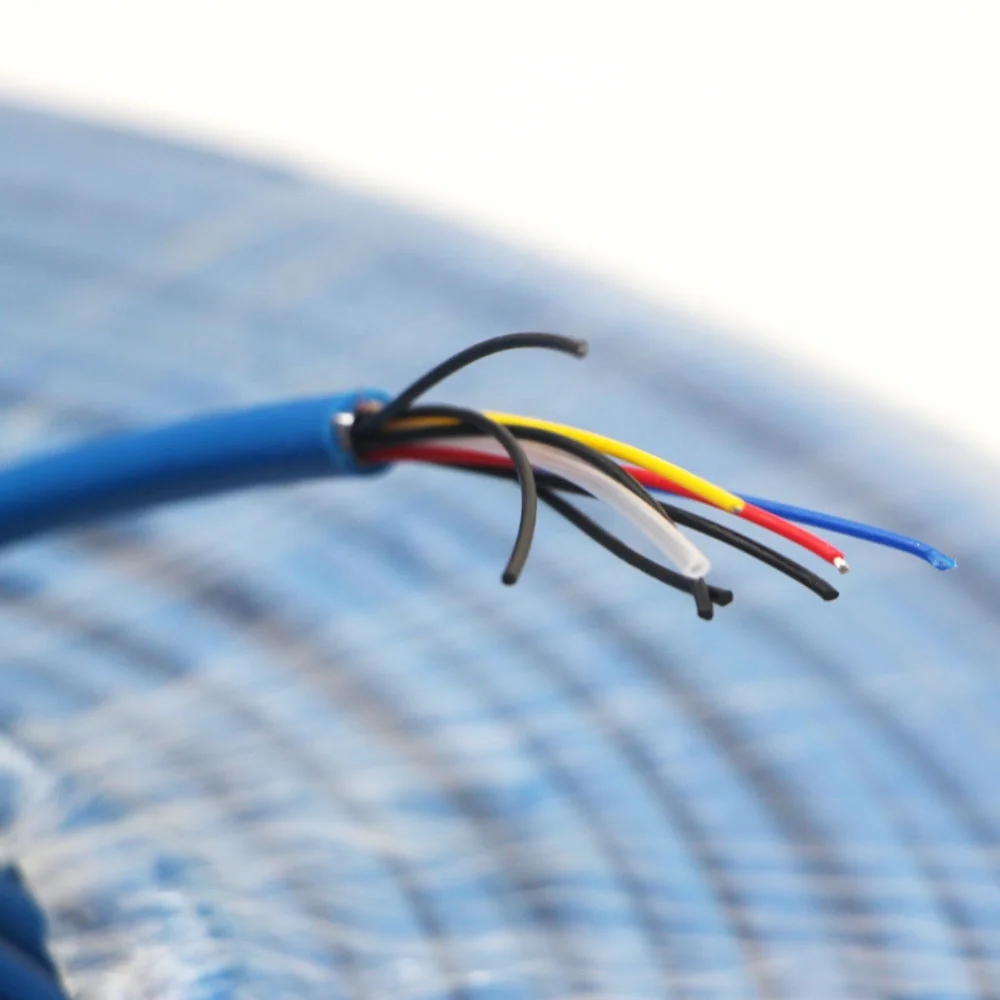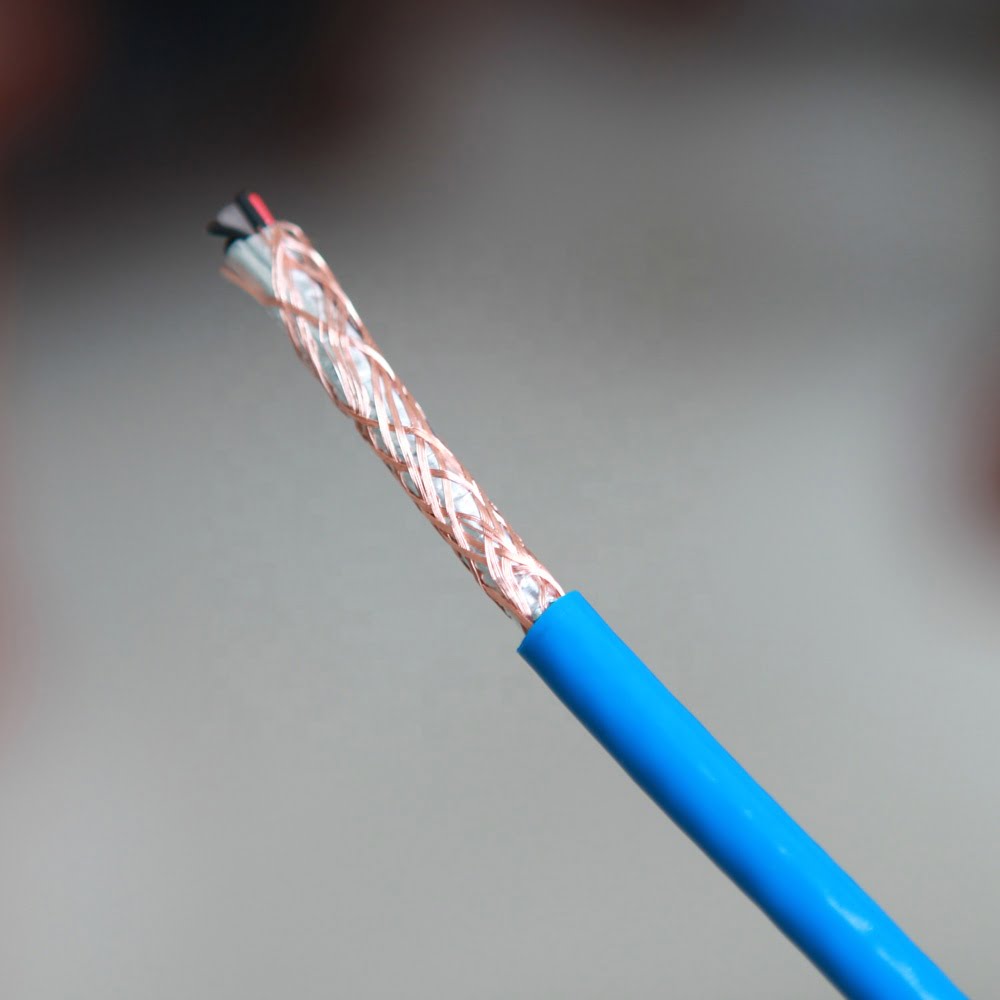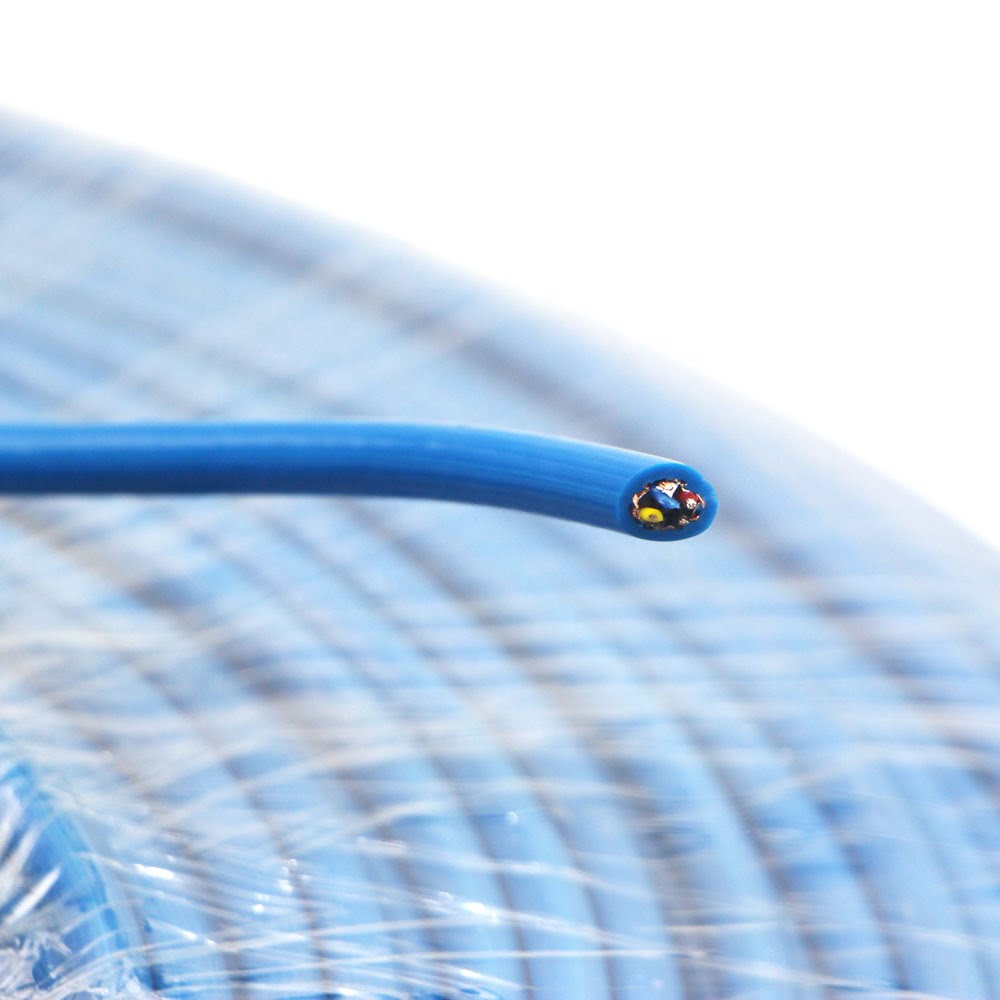مقدمة ل 4 الكابلات الأساسية مع أنابيب تنفيس

في السنوات الأخيرة, 4 ظهرت الكابلات الأساسية ذات أنابيب التهوية كمكونات أساسية في مجال الهندسة, لا سيما في التطبيقات المتعلقة بقياس ضغط المياه والكشف عن مستوى السوائل. تم تصميم هذه الكابلات المتخصصة لتوفير قياس موثوق ودقيق لمعلمات السوائل المختلفة, وهو أمر بالغ الأهمية للعديد من الصناعات, بما في ذلك البناء, المراقبة البيئية, وإدارة الموارد المائية. تكمن أهمية هذه الكابلات في تصميمها الهيكلي فحسب ، بل في وظائفها أيضًا, الذي يدمج التكنولوجيا المتقدمة لتحسين الأداء.
الهيكل الأساسي ل 4 يتضمن الكبل الأساسي عادة أربعة موصلات تمكن من نقل البيانات المتعلقة بالإشارات الكهربائية التي تم إنشاؤها بواسطة مستشعرات الضغط. إن إدراج أنابيب التهوية يسهل التواصل مع محولات الضغط بطريقة تعوض عن تقلبات الضغط في الغلاف الجوي. هذا التصميم مهم بشكل خاص في البيئات التي يمكن أن تتغير فيها مستويات المياه والضغوط بسرعة بسبب الظروف البيئية. نظرًا لأن مثيلات الماء غالبًا ما تتعرض لتغيرات الضغط في الغلاف الجوي, يضمن استخدام الكابلات مع أنابيب التهوية أن تظل القياسات دقيقة وموثوقة, وبالتالي تجنب عدم دقة البيانات المحتملة.
تستخدم هذه الكابلات على نطاق واسع في سيناريوهات تتراوح من مراقبة مستويات المياه في الخزانات, لإدارة الضغط في أنظمة المياه الصناعية. من خلال الحفاظ على ضغط مرجعي مستقر من خلال أنابيب التهوية, يمكن للمهندسين الحصول على قياسات واقعية تبلغ عمليات صنع القرار. بالإضافة إلى, براعة 4 تتيح لهم الكابلات الأساسية استخدامها في مجموعة متنوعة من المنشآت, من التطبيقات على مستوى السطح إلى أنظمة البئر العميقة, تعزيز فائدتها عبر مختلف المجالات الهندسية.
أخيرًا, فهم أهمية 4 الكابلات الأساسية مع أنابيب التهوية ضرورية للمهنيين المشاركين في العلوم الهندسية والبيئية, نظرًا لأن هذه الكابلات لا تعمل على تحسين دقة القياس فحسب ، بل تسهل أيضًا الإدارة الفعالة والرقابة على موارد المياه.
فهم قياس ضغط الماء

يعد قياس ضغط المياه جانبًا مهمًا في مختلف الصناعات مثل الهيدرولوجيا, السباكة, والمراقبة البيئية. يدور المفهوم حول فهم القوة التي تمارسها الماء, والتي يمكن أن تؤثر بشكل كبير على كفاءة النظام وسلامة النظام. يهتم قياس الضغط في المقام الأول بتقدير الضغط في نظام الماء, تقاس عادة بالجنيه لكل بوصة مربعة (PSI) أو pascals (السلطة الفلسطينية). بالإضافة إلى ذلك, تعد القراءات الدقيقة أمرًا بالغ الأهمية لمراقبة سلامة أنظمة توصيل المياه وضمان بقاء مستويات الضغط ضمن التحمل التشغيلي الآمن.
يتم استخدام عدة أنواع من أجهزة الاستشعار لقياس ضغط الماء, مع امتلاك كل مزايا مميزة اعتمادًا على التطبيق. تشمل أنواع المستشعرات الشائعة piezoresive, تسعية, وأجهزة استشعار مقياس الإجهاد. يتم تقدير أجهزة الاستشعار piezoresistive بشكل خاص لدقتها واستجابةها, جعلها مناسبة للتطبيقات التي تتطلب قياسات ضغط دقيقة. تقدم المستشعرات السعية مقاربة مختلفة, لأنها تقيس الضغط بناءً على التغيرات في السعة, بينما تعمل أجهزة استشعار مقياس الإجهاد عن طريق قياس التشويه في مادة تحت الضغط. يوفر كل نوع مستشعر فوائد فريدة من حيث الحساسية والموثوقية, السماح بحلول مصممة على أساس متطلبات تشغيلية محددة.
لتسهيل انتقال البيانات الفعال من هذه المستشعرات إلى أنظمة المراقبة, 4 كثيرا ما يتم استخدام الكابلات الأساسية. تتكون هذه الكابلات المتخصصة من أربعة موصلات, التي تعزز قدرات الاتصال من خلال السماح بإرسال إشارات متعددة في وقت واحد. تصميم 4 الكابلات الأساسية, غالبًا ما يتم دمجه مع أنابيب التهوية, يضمن أن يتم توصيل أي اختلافات ضغط تم اكتشافها بواسطة المستشعر بدقة وكفاءة إلى أنظمة المراقبة. يعد هذا النقل السلس للبيانات ضروريًا لإنشاء نظرة عامة شاملة على ظروف ضغط المياه. تلعب قراءات ضغط المياه الدقيقة دورًا حيويًا في منع فشل النظام, تحسين العمليات, وضمان الامتثال للمعايير التنظيمية في مختلف القطاعات.
أهمية أنابيب التهوية في تصميم الكابلات

تلعب أنابيب التهوية دورًا مهمًا في الوظيفة الكلية لـ 4 الكابلات الأساسية, خاصة تلك المصممة لقياس ضغط الماء. تعمل هذه الأنابيب كمكونات أساسية تسمح بالمعادلة الدقيقة للضغط الجوي داخل النظام. في الإعدادات حيث يكون قياس مستوى السائل أمرًا حيويًا, كما في أنظمة إدارة المياه, يعد وجود أنابيب تنفيس أمرًا ضروريًا لضمان أن أجهزة الاستشعار والمحولات يمكنها تقديم قراءات دقيقة.
الوظيفة الأساسية لأنابيب التهوية هي السماح للهواء بدخول الكبل, الذي يساعد على تحقيق التوازن بين الضغوط الداخلية والخارجية التي تمارسها على جهاز الاستشعار. عندما يرتفع السائل أو يسقط داخل جهاز القياس, تحدث الاختلافات في الضغط. بدون أنابيب تنفيس, يمكن أن تؤدي هذه التغييرات إلى قراءات خاطئة, نظرًا لأن الفرق في الضغط قد يتسبب في استجابة المستشعرات بشكل غير دقيق. عن طريق معادلة الضغط, تساعد أنابيب تنفيس على تخفيف هذه التناقضات, مما يؤدي إلى قياسات مستوى السوائل الموثوقة والمتسقة.
بالإضافة إلى, تعد أنابيب التهوية مفيدة في منع تراكم الضغط السلبي, والتي يمكن أن تؤثر سلبا على أداء نظام قياس الضغط. في الظروف البيئية المتقلبة, مثل أثناء هطول الأمطار الغزيرة أو التبخر السريع, ضمان بقاء مستويات الضغط مستقرة أمر بالغ الأهمية. تسهيل أنابيب التهوية هذا الاستقرار من خلال السماح بالهروب من الهواء المحاصر والرطوبة, وبالتالي تقليل خطر حدوث أخطاء القياس المتعلقة بالضغط التي قد تعرض للبيانات التي تم جمعها على خلاف ذلك.
في ملخص, دمج أنابيب التهوية في تصميم 4 تعزز الكابلات الأساسية دقة وموثوقية أنظمة قياس ضغط المياه. عن طريق معادلة الضغط بشكل فعال ومنع التداخل في الغلاف الجوي, تضمن هذه الأنابيب أن تعمل أدوات القياس بكفاءة, حتى في الظروف البيئية المتنوعة والمتغيرة.
الخصائص الميكانيكية والمقاومة البيئية
4 يتم تصميم الكابلات الأساسية ذات أنابيب التهوية لإظهار خصائص ميكانيكية استثنائية, جعلها مثالية لمختلف التطبيقات, لا سيما في البيئات الصعبة مثل أنظمة مياه الصرف الصحي والتنظيف. واحدة من الميزات البارزة لهذه الكابلات هي مقاومتها الميكانيكية العالية, الذي يسمح لهم بتحمل الإجهاد البدني الكبير دون المساومة على سلامتهم. هذه المتانة مهمة في السيناريوهات التي قد تواجه فيها الكابلات سحجات أو آثار من العناصر الخارجية, ضمان أداء ثابت بمرور الوقت.
سمة مفتاح أخرى من 4 الكابلات الأساسية هي مرونتها. هذه الخاصية تسهل تسهيل التثبيت والتوجيه من خلال المساحات الضيقة, الذي غالبًا ما يكون مطلبًا في أنظمة الصرف الصحي أو البنية التحتية للتنظيف. تمكنهم مرونة هذه الكابلات من الانحناء والتحديد حول العقبات, التأكد من أنه يمكن نشرها بطريقة تقلل من نقاط الإجهاد ونقاط الفشل المحتملة. هذه القدرة على التكيف مفيدة في التطبيقات التي قد لا تكون فيها الكابلات التقليدية قابلة للحياة بسبب التخطيطات غير الخطية لشبكات مياه الصرف الصحي والمياه.
علاوة على ذلك, 4 تعرض الكابلات الأساسية مقاومة بيئية كبيرة, which is fundamental in settings exposed to harsh chemicals and varying temperatures. The materials used in manufacturing these cables are designed to resist corrosion and degradation caused by exposure to toxic substances often found in wastewater or cleaning solutions. As a result, they maintain their functionality and longevity, providing reliable operation even in the most adverse conditions. The combination of mechanical strength and environmental resilience renders these cables an optimal choice for professionals focused on ensuring efficient water pressure measurement in challenging settings.
Electrical Specifications and Safety Standards
When discussing 4 core cables with vent tubes used for water pressure measurement, understanding their electrical specifications is paramount. These cables are designed to operate effectively under specific conditions, including an operating voltage typically ranging from 300V to 600V. This voltage rating ensures that the cables can handle the electrical demands common in water pressure measurement systems without compromising safety or functionality.
Another crucial specification is insulation resistance, which usually exceeds 1000 megohms at 500V DC. High insulation resistance plays a significant role in preventing electrical leakage, promoting overall system efficiency, and ensuring user safety. In addition to these core specifications, the cables often exhibit characteristics such as low capacitance, which further enhances signal integrity and reduces interference in measurement outputs.
Adhering to established safety standards is vital in the application of these cables. Cables designed for pressure measurement in water systems must comply with relevant national and international safety guidelines, such as IEC 60529, which addresses the degree of protection provided by enclosures (IP ratings). Ensuring proper insulation, moisture resistance, and cable integrity prevents potential hazards, including short circuits and electrical fires.
علاوة على ذلك, these specifications contribute to the longevity and reliability of the cables in demanding environments. على سبيل المثال, exposure to water and other harsh conditions can degrade inferior products quickly. لذلك, choosing cables with robust insulation and protective features is essential for maintaining operational effectiveness in water pressure measurement applications. Overall, a comprehensive understanding of the electrical specifications and adherence to safety standards guarantees the safe and efficient functioning of 4 core cables with vent tubes.
Core Configuration and Color Coding
The core configuration of 4 core cables with vent tubes used for water pressure measurement plays a critical role in ensuring accurate data transmission and efficient operation of the associated sensors. These cables typically feature conductors with a cross-section that is optimized for both flexibility and conductivity. The choice of the conductor’s size impacts the cable’s electrical resistance, allowing for minimal signal loss and increased responsiveness. For effective performance, the cross-sectional area must be sufficient to carry the expected load without overheating. هكذا, manufacturers often recommend specific conductor sizes based on the anticipated range of water pressure measurements.
In addition to the conductor cross-section, the color coding of the cables significantly enhances the usability and safety of these components during installation and maintenance. The standard color scheme employs four distinct colors: red, green, white, and black. Each color is designated a specific function to streamline the identification process. على سبيل المثال, the red conductor typically correlates with positive voltage supply, ensuring that users can easily connect the cable to the appropriate terminal without confusion. Green often represents the ground connection, which is crucial for safety and the prevention of electrical shocks.
Meanwhile, the white conductor is generally utilized for sensor signal transmission, facilitating data transfer to the monitoring system. The black conductor typically serves as the negative or return path for the circuit. This systematic color coding not only minimizes installation errors but also aids technicians during troubleshooting and maintenance activities. As a result, the clear identification of functions through color coding contributes to the reliability and efficiency of water pressure measurement systems. Overall, understanding both the core configuration and the associated color coding is essential for anyone involved in the installation or maintenance of these specialized cables.
Operating Conditions and Temperature Ranges
The operational effectiveness of 4 core cables with vent tubes largely hinges on the environmental conditions and temperature ranges within which they are deployed. These cables are engineered to withstand a diverse array of operating scenarios, making them suitable for various applications, particularly in water pressure measurement systems. Specifically, these cables exhibit remarkable durability under extreme temperatures that range from -30℃ to 75℃. This versatility ensures reliable performance in diverse environments, whether in frigid outdoor conditions or in relatively hot industrial settings.
Maintaining operational integrity under such temperature variations is vital for long-term applications, particularly in fields such as environmental monitoring, industrial settings, and civil engineering. At temperatures as low as -30℃, the physical and electrical properties of the cables remain intact, thereby preventing failures and ensuring consistent readings. بصورة مماثلة, at elevated temperatures up to 75℃, the integrity of the 4 core cables is preserved, allowing them to function efficiently in high-stress environments aimed at precise water pressure measurements.
علاوة على ذلك, these cables’ resistance to environmental factors such as humidity, abrasion, and chemical exposure contributes to their overall reliability and lifespan. The incorporation of vent tubes further enhances this design by preventing moisture ingress, which is crucial for maintaining the function of the underlying sensors. As a result, applications involving these cables can be deployed in varied locations, including underground installations and exposed outdoor environments, without compromising performance. Understanding these operating conditions and temperature ranges is essential for professionals tasked with selecting appropriate components for water pressure measurement systems, ensuring that the infrastructure remains robust over time.
Durability and Mechanical Performance Metrics
When evaluating the performance of 4 core cables with vent tubes, it’s essential to consider their durability and mechanical performance metrics. Two critical parameters to assess are the breaking load and the bending radius, both of which provide insights into the physical limits of these cables and their suitability for various applications.
The breaking load refers to the maximum load that a cable can withstand before experiencing failure or breakage. This metric is vital for understanding how much stress the cable can endure during its service life. For applications involving water pressure measurement, such as in deep-water installations, the breaking load becomes crucial in determining the cable’s ability to survive extreme conditions without compromising integrity. Depending on the application, engineers should select cables that not only meet the required breaking load specifications but also offer a safety margin, ensuring long-term reliability.
Another significant factor is the bending radius, which indicates the smallest radius that the cable can be bent without incurring damage. A small bending radius may lead to kinks or compromises in the cable’s functionality. It is particularly important when routing cables through tight spaces or around sharp corners. Understanding the minimum bending radius allows for better planning in cable installation, helping to avoid inadvertent damage that could lead to costly repairs or downtime.
In practical applications, both breaking load and bending radius should be taken into consideration together. على سبيل المثال, when installing 4 core cables with vent tubes in environments where they may be subject to tension or physical constraints, both metrics will guide professionals to make informed decisions regarding cable selection and installation methods. Ensuring optimal performance under operational scenarios is foundational for effective water pressure measurements.
Conclusion and Future Perspectives
في ملخص, the exploration of 4 core cables with vent tubes for water pressure measurement has revealed their critical role in ensuring accuracy and reliability. These specialized cables are designed to withstand the harsh environments typically encountered in water pressure applications, significantly elevating performance standards. Throughout this discussion, we have highlighted how the unique design elements of these cables promote effective pressure transmission, while their durability ensures a long service life even under challenging conditions.
As industries increasingly rely on precise water pressure measurements for various applications, such as hydrostatic testing, aquaculture, والمراقبة البيئية, the importance of selecting the right cable cannot be understated. The integration of vent tubes into 4 core cables plays a pivotal role in alleviating internal pressures and minimizing the risk of measurement errors. This synergy between cable design and functionality is paramount for engineers and technicians involved in water management systems.
Looking towards the future, advancements in cable technology are expected to yield even more robust solutions. Innovations, such as improved materials that enhance the durability and flexibility of these cables, may significantly contribute to achieving heightened accuracy in pressure readings. علاوة على ذلك, the potential for smart cable solutions, incorporating sensors and data transmission capabilities, could revolutionize the way water pressure is monitored and managed across various sectors.
ختاماً, as we continue to advance in the field of cable technology, the prospects for new applications and improved reliability in water pressure measurement will expand. The emphasis on selecting quality 4 core cables with vent tubes will remain crucial to meet the demands of an evolving industry, ultimately leading to more efficient water resource management practices.

